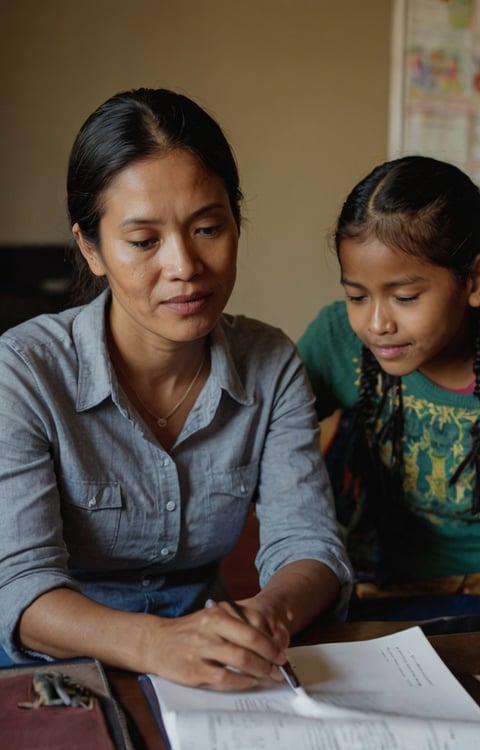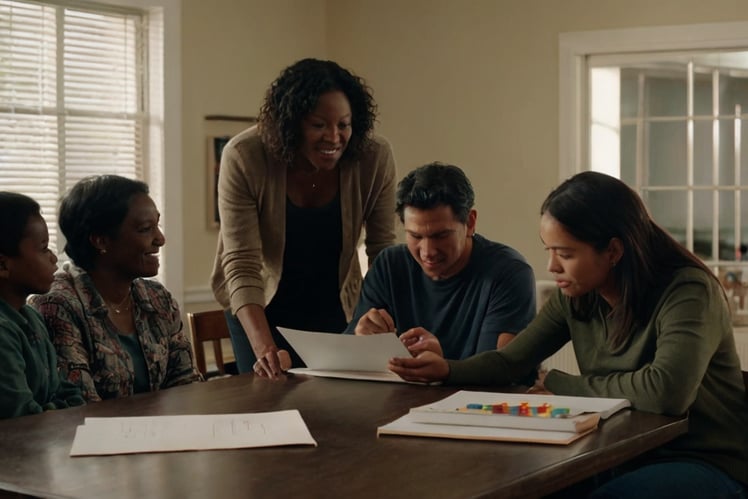
Parent Effectiveness Training: A Comprehensive Guide to Raising Emotionally Intelligent Children
Unlock the secrets of Parent Effectiveness Training: A Comprehensive Guide to Raising Emotionally Intelligent Children! Discover how this approach to parenting can foster emotional intelligence, enhance communication, and resolve conflicts between parents and children. Dive into expert-backed strategies, real-world examples, and powerful insights to help your family thrive!
PARENTING STRESS
3/10/20256 min read
Parent Effectiveness Training (P.E.T.) has proven itself to be a transformative tool for families who want to establish stronger connections and navigate the complexities of modern parenting.
We’ve seen, both personally and professionally, how challenging it can be to balance all the demands of family life, and how it often leads to stress and frustration. Reflecting on insights from articles like what is parental stress, the science behind parental stress, and common triggers of parental stress and how to recognize them, we recognize how common these struggles are across families. Parenting can be overwhelming at times, but it doesn’t have to mean constant conflict. P.E.T. teaches parents how to turn conflict into collaboration by creating win-win solutions.
This approach aligns with our own beliefs about the importance of mutual respect, effective communication, and empathy in resolving everyday challenges, as discussed in parental stress vs. burnout. Through understanding the hidden costs of parental stress on family dynamics and practicing 11 proven strategies to reduce parental stress today, we can apply these concepts practically in our lives and benefit from a more balanced, healthier family environment.
What is Parent Effectiveness Training (P.E.T.) and How Does it Benefit Both Parents and Children?
Parent Effectiveness Training (P.E.T.) focuses on creating open communication and mutual respect between parents and children, ultimately fostering stronger relationships and reducing conflict.
Unlike traditional parenting methods that rely heavily on commands, punishments, or rewards, P.E.T. emphasizes collaboration, problem-solving, and mutual understanding.
Through P.E.T., parents learn to use active listening, assertive communication, and problem-solving techniques to resolve conflicts in a way that benefits both parties.
The core philosophy of P.E.T. is based on the idea that children are capable of understanding their parents' viewpoints and that positive relationships can be built through mutual respect and cooperation.
The program encourages parents to shift from a "top-down" approach to a "partnership" model of parenting. This means involving children in the decision-making process, validating their emotions, and working together to find solutions to problems rather than imposing authority or punishment.


Conflict Resolution Strategy: A Win-Win for Parents and Children
At the core of Parent Effectiveness Training (P.E.T.), we find a powerful conflict resolution strategy that emphasizes finding solutions that benefit both parents and children.
We’ve experienced firsthand how traditional parenting methods often fall short, relying heavily on commands, punishments, or rewards that foster a win-lose dynamic. Such methods leave one party feeling unheard or alienated.
In contrast, P.E.T. offers a collaborative approach that encourages both the parent and child to work together in resolving conflicts, fostering a sense of teamwork. This collaborative problem-solving creates a much more positive and empowering atmosphere for both sides.
Key Steps in P.E.T. Conflict Resolution
Key Steps in P.E.T. or key principles of P.E.T. serve a s a foundation of its proper and successful application.
They are as follows:
· Active Listening: We’ve learned that it’s crucial for parents to truly listen to their child’s perspective. We know that this involves not only hearing the words but also understanding the emotions behind them. When we listen carefully, without judgment or interruption, the child feels heard and valued, which can immediately de-escalate potential conflicts.
· Assertive Communication: After understanding the child’s needs, we practice assertive communication ourselves. This means we express our needs and feelings clearly and respectfully, without aggression or passivity. This open communication fosters empathy, as both the parent and the child can see each other’s perspectives.
· Problem Solving: The real magic happens when we work together to find solutions that satisfy both parties. From our experience, this approach encourages the child to think critically and collaboratively, helping them learn essential problem-solving skills they’ll carry with them throughout life.
Through this approach, we’ve seen children develop better emotional intelligence, social skills, and self-esteem. These benefits are critical for their overall growth, while parents feel more confident in their ability to handle everyday conflicts.


Understanding Children’s Needs Through the Lens of Maslow’s Hierarchy
We often turn to Maslow’s Hierarchy of Needs when we think about understanding children’s behavior. As parents, we know that children's behavior is often rooted in unmet needs that can be difficult to identify at first.
Maslow's theory is a helpful way to categorize these needs, from basic survival needs to higher psychological needs. Understanding where our children’s needs fall on this hierarchy can provide vital insight into how best to respond to their behavior.
Maslow’s Hierarchy of Needs
Physiological Needs: These include basic survival needs like food, water, shelter, and rest.
Safety Needs: Children need security and protection from harm.
Love and Belonging: Emotional connection with family, friends, and groups.
Esteem Needs: Respect, self-esteem, and recognition from others.
Self-Actualization: The realization of one’s full potential and creative expression.
As parents, we’ve found that children who act out may be struggling with unmet physiological needs—perhaps they’re hungry, tired, or in need of comfort.
If a child craves attention, it could be related to emotional needs like esteem or belonging. Recognizing these needs in the right order is essential to effectively address the behavior.
By focusing on meeting these needs in sequence, we can provide a supportive environment that nurtures our child’s emotional and psychological growth.
This aligns perfectly with P.E.T., where parents are guided to assess and respond to children’s needs thoughtfully, reducing behavioral issues and creating a stronger parent-child relationship.


How to Select the Right Parenting Program
When we set out to choose the right parenting program, we knew that it had to fit both our parenting style and our family's unique needs.
Through our research and experience, we’ve discovered a few key factors to consider when choosing a program like P.E.T.
Key Considerations in Choosing a Parenting Program
Approach and Methodology: We want a program that prioritizes communication, mutual respect, and problem-solving over punitive tactics. P.E.T. provides exactly this, fostering an environment of collaboration rather than command and control.
Evidence of Effectiveness: After researching numerous programs, we were drawn to P.E.T. because of its strong track record of success. Studies consistently show that P.E.T. improves parent-child relationships, reduces problematic behaviors, and increases parental confidence.
Flexibility: Parenting isn’t one-size-fits-all, and we appreciate that P.E.T. allows room for customization. It offers flexibility, making it adaptable to our specific challenges and family dynamics.
Support System: A program is only as good as the ongoing support it provides. P.E.T. offers follow-up sessions, online resources, and a community of parents to help us implement what we’ve learned.
In our experience, P.E.T. stands out because it actively engages both parents and children, creating an ongoing dialogue and partnership for lasting change.


Evidence Supporting the P.E.T. Approach to Parenting
We’ve reviewed plenty of studies and literature supporting P.E.T., and the evidence is clear: this approach works. Research has shown that P.E.T. improves parenting skills, reduces aggression and disruptive behaviors, and strengthens the parent-child relationship.
For example, the study by Gubbels et al. (2019) revealed that parent training programs like P.E.T. significantly reduce child maltreatment and improve overall parenting practices.
This research highlighted the importance of emotional support and positive reinforcement in fostering healthy parent-child interactions. We’ve found similar findings in other studies, such as those by Kazdin (1997), which show how P.E.T. promotes communication and behavioral management techniques that encourage cooperation and resolve conflict.
The long-term impact is equally significant—Helander et al. (2024) found that parents who engaged in P.E.T. experienced enduring benefits in both their well-being and their children’s emotional growth.


Conclusion
In our journey with Parent Effectiveness Training, we’ve discovered how powerful a tool it can be for fostering collaboration, empathy, and effective communication in families.
By using P.E.T., parents can transform conflicts into opportunities for mutual understanding and growth, creating a nurturing environment that supports both emotional and psychological development.
The insights we’ve gained from Maslow’s Hierarchy of Needs and from carefully selecting the right parenting program only enhance the effectiveness of these strategies.
Ultimately, P.E.T. has proven to be a valuable resource for any family seeking to navigate the challenges of modern parenting, offering evidence-backed methods that strengthen the bond between parents and children.
References:
Gubbels, J., van der Put, C. E., & Assink, M. (2019). The Effectiveness of Parent Training Programs for Child Maltreatment and Their Components: A Meta-Analysis. International Journal of Environmental Research and Public Health, 16(13), 2404.
Helander, M., Asperholm, M., Wetterborg, D. et al. The Efficacy of Parent Management Training With or Without Involving the Child in the Treatment Among Children with Clinical Levels of Disruptive Behavior: A Meta-analysis. Child Psychiatry Hum Dev 55, 164–181 (2024).
Li, H.C.W., Chan, S.S., Mak, Y.W. et al. Effectiveness of a parental training programme in enhancing the parent–child relationship and reducing harsh parenting practices and parental stress in preparing children for their transition to primary school: a randomised controlled trial. BMC Public Health 13, 1079 (2013).
Rossi, C. (n.d.). Parent training programs: Insight for practitioners. PsycEXTRA Dataset. American Psychological Association. Retrieved from PsycEXTRA Dataset.
Kazdin, A. E. (1997). Parent management training: Evidence, outcomes, and issues. Journal of the American Academy of Child & Adolescent Psychiatry, 36(10), 1349-1356.
